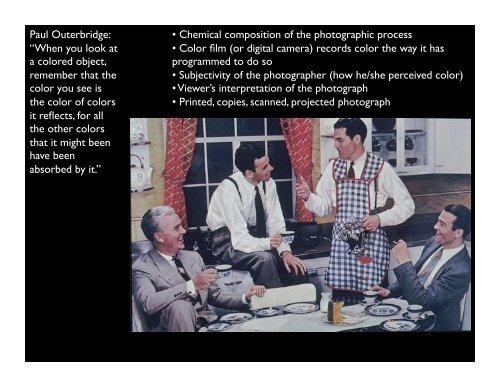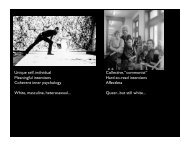Photo_Color_Real.pdf
Photo_Color_Real.pdf
Photo_Color_Real.pdf
You also want an ePaper? Increase the reach of your titles
YUMPU automatically turns print PDFs into web optimized ePapers that Google loves.
Paul Outerbridge:!<br />
“When you look at<br />
a colored object,<br />
remember that the<br />
color you see is<br />
the color of colors<br />
it reflects, for all<br />
the other colors<br />
that it might been<br />
have been<br />
absorbed by it.”!<br />
•! Chemical composition of the photographic process!<br />
•! <strong>Color</strong> film (or digital camera) records color the way it has<br />
programmed to do so!<br />
•! Subjectivity of the photographer (how he/she perceived color)!<br />
•! Viewer’s interpretation of the photograph!<br />
•! Printed, copies, scanned, projected photograph!
Roland Barthes, Camera Lucida!<br />
Believed that color ruined<br />
photography’s basic<br />
truthfulness, describing it as a<br />
“coating applied later on to the<br />
original truth of the black and<br />
white photograph. For me,<br />
color is an artifice, a cosmetic<br />
(like the kind used to paint<br />
corpses).”!<br />
Walker Evans, 1969:!<br />
“These are four words which<br />
must be whispered: color<br />
photography is vulgar.”!<br />
Edward Steichen:!<br />
"The palette and canvas are a<br />
dull and lifeless medium by<br />
comparison.”!<br />
Edward Steichen, The Pond – Moonrise, 1904, !<br />
Platinum print with applied color!<br />
Sells for almost $3 million at Sotheby’s in 2006!
Additive color photography!<br />
James Clerk Maxwell!<br />
Shoots subject using three separate<br />
red, green, and blue filters. Then,<br />
projects three black and white positives<br />
made from these negatives through a<br />
magic lantern using the same red, green,<br />
and blue filters. When the three images<br />
were superimposed on the screen, a<br />
color image appeared.!<br />
Difficulty:!<br />
Making a print rather than projection!<br />
Subtractive color photography!<br />
Subtracts some color from white light allowing other<br />
to remain. Uses the selective removal of wavelengths<br />
from light to produce a color. !<br />
Advantage:!<br />
The basis for all future twentieth-century color<br />
photography.!<br />
A matter of figuring it out...!<br />
•! A one-shot color camera using triple negatives!<br />
•! Tripack film system!
Louis Lumiere, Tea Room, 1907, Autochrome!<br />
Microscopic grains of potato starch act as tiny<br />
colored filters.!<br />
Dusted onto a plate with panchromatic silver<br />
bromide emulsion.!<br />
Light passes through filters before striking<br />
emulsion on the back of the plate.!<br />
Advantages:!<br />
•!Can be used with any plate camera system!<br />
•! Excessive sensitivity to blue/ultra-violet light<br />
(necessary to use yellow/orange filter)!<br />
Disadvantages:!<br />
•!Long exposure time; revert to 19 th century<br />
standards of stillness!<br />
•!Single, one-off image on a plate, like the<br />
daguerreotype.!<br />
•!Difficult to reproduce!<br />
•!Difficult to manipulate!<br />
•!Expensive and emulsion quality differs!
Charles C. Zoller, Butterfly Collection, c. 1907-32!
Alvin Coburn, Samuel Longhorn Clemens, 1908!
“Only somebody<br />
who possess a<br />
delicate sense of<br />
color should work<br />
with the autochrome<br />
process, the palette is<br />
somewhat<br />
dangerously colorful.”!<br />
Heinrich Kühn, Lotte,<br />
1908!
Leon Gimpel<br />
Sculptor and his Model ! !!<br />
1911 !!
Fernand Cuville, War Trophies, 1918 !!
Sergei Prokudin-<br />
Gorskii!
Leica: 1925!<br />
Kodachrome: 1935 (three-layer emulsion film)!<br />
Kodacolor: 1942!<br />
Standarization and commercialization of tricolor printing process!<br />
Rise of illustrated magazines:!<br />
National Geographic!<br />
Ladies’ Home Journal!<br />
Berliner Illustrierte Zeitung!<br />
Fashion magazines: Vogue, Vanity Fair, Harper’s Bazaar!<br />
Influence of modern art movements:!<br />
Constructivism, Surrealism, Expressionism!<br />
Demands of commercial film, converting from b&w to color!
Edward Steichen, Yucatan: Mayan Women, dye transfer print from 35 mm Kodachrome, 1938 !!
Steichen on Kodachrome:!<br />
“...more of a liability than an<br />
asset for it brought forth an<br />
orgy of color. Instead of colorful<br />
picture we had coloriferous<br />
images.”!
Paul Outerbridge, Coffee Drinkers, 1939!<br />
Harold Haliday Costain:"<br />
“The most noticeable recent change in<br />
advertising tendencies is the widespread use<br />
of color photography for all types of<br />
illustrations. The American advertisers,<br />
realizing that over 75% of all purchases were<br />
made by our women, set about to further<br />
appeal to them by means of color, and the<br />
great increase in its general use proves<br />
beyond a doubt its claim to success.”!
Nickolas Muray, Camel Girl in Pool, 1936, carbro print!
Paul Outerbridge, Jr., Woman with Claws, 1937!<br />
Paul Outerbridge, Jr., Woman with Snake, 1938!
Madame Yevonda,<br />
Mrs. Edward Mayer as<br />
Medusa Goddess, c.<br />
1935, permaprint<br />
pigment transfer<br />
from glass negatives!<br />
“<strong>Photo</strong>graphers have<br />
little or no sense of<br />
color and if they<br />
ever possessed such<br />
a quality it has<br />
become warped or<br />
nonexistent through<br />
years of disuse.”!
Madame Yevonda,<br />
Mrs. Edward Mayer as<br />
Medusa Goddess, c.<br />
1935, permaprint<br />
pigment transfer<br />
from glass negatives!<br />
“<strong>Photo</strong>graphers have<br />
little or no sense of<br />
color and if they<br />
ever possessed such<br />
a quality it has<br />
become warped or<br />
nonexistent through<br />
years of disuse.”!
Hans Bellmer, La Poupee, 1938!<br />
Hans Bellmer, Les Jeux de la Poupee,<br />
published 1949!
Hans Ernst, Poster Painter, Times Square, 1952!
Eliot Porter, Red<br />
Osier, New Great<br />
Barrington,<br />
Massachussets,<br />
1957!<br />
“A film of water<br />
on a rock<br />
surface...may<br />
reflect the light<br />
of the day after<br />
absorbing the<br />
longer<br />
wavelengths and<br />
be as blue as the<br />
surface of the<br />
sea, or it might<br />
reflect the color<br />
of a sunlit<br />
sandstone cliff<br />
and become a<br />
band of gold.”!
1960: Polaroid!<br />
1962: First solo color photography exhibition at MOMA (Ernst Haas)!<br />
1963: Cibachrome!<br />
1970s: Institutional acceptance of color photography in museums!<br />
! Professionalization and education programs in photography!<br />
1976: First color catalogue of one-man show (Eggleston)!<br />
Nature, landscape, portrait, fashion, advertising, war, social documentary. !
William Eggleston, Red Room, 1972!<br />
In the past decade a number of photographers<br />
have begun to work in color in a more<br />
confident, more nature, and yet more<br />
ambitious spirit, working not as though color<br />
were a separate issue...but rather as though<br />
the world itself existed in color.” !<br />
– John Szarkowski!
William Eggleston, Los Alamos, 1966-74!
Stephen Shore, Holden St., North Adams, Mass., 1974!
Joel Sternfeld, McLean, Virginia, 1978!
Lucas Samaras,<br />
<strong>Photo</strong>-<br />
Transformation<br />
SX-70 Polaroid,<br />
1973-74!
Lucas Samaras,<br />
<strong>Photo</strong>-<br />
Transformation,<br />
1973-74!
Jeff Wall, A Gust of Wind (After Hokusai), transparency, 1993!
Andres Gursky, 99 Cent, chromogenic color print, 1999!




